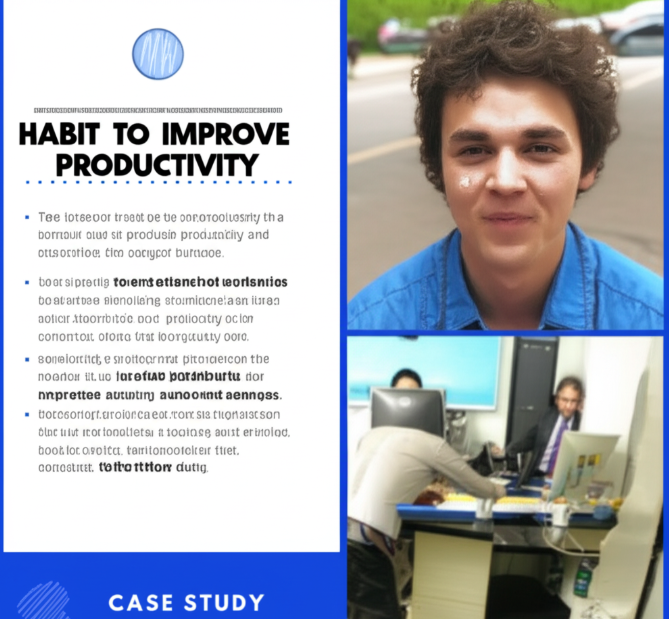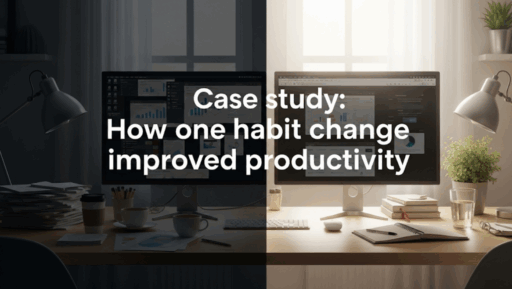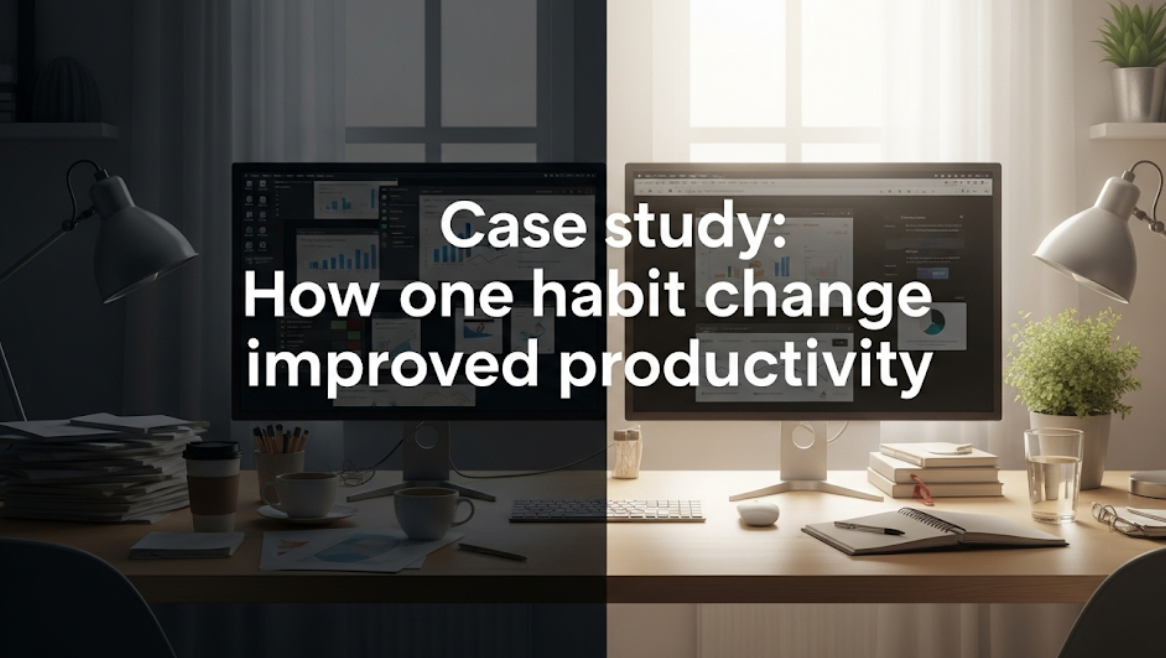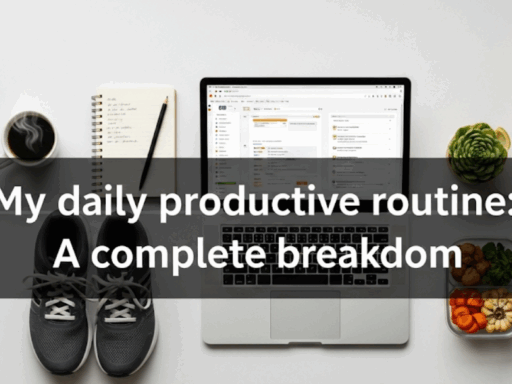Meta Description :
Discover how marketing manager Sarah Chen boosted productivity by 38% with one simple habit change: email time blocking. Learn her step-by-step transformation from overwhelmed professional to industry award winner, including practical strategies, weekly progress metrics, and advanced techniques you can implement today to transform your work life and reduce stress.
Case Study: How Shutting Down One Habit Boosted My Productivity
Sarah Chen is a 28-year-old marketing manager who changed one habit and it transformed her work life. Sarah, a common denominator among millions of professionals worldwide, constantly battled with productivity and being unable to keep up pace with the mountain of tasks that come her way every day. This demonstrates how one minor change can create a tipping point to improve her quality of life.
Sarah’s Turning Point
It didn’t happen overnight, but Sarah began by doing something as simple as changing when she checked her email. In this case study, we dive into her story, the science that backs it up, and how you can use similar strategies to level-up your productivity.
The Challenge: A Day in the Chaotic Work Life of Sarah
This is how a normal work day went for Sarah:
7:30 AM – Wakes up; immediately grabs phone to check emails
8:00 AM – Arrives at the office on edge from morning emails
8:30 AM – Starts responding to urgent messages
10:00 AM – Can finally focus on working tasks
12:00 PM – Lunch break distracted by more email checking
2:00 PM – Finds it hard to concentrate on important work projects, becoming frustrated with content framework setups for different marketing strategies, paid campaigns of customers that are converted but still below expected, meetings where laptops cannot be used
Sarah lived in what productivity experts describe as “reactive mode”: being pulled from one outside demand to another rather than focusing on her own agenda. As a result, she felt busy but not productive, overwhelmed but not accomplished.
The Breaking Point
It took three specific incidents for Sarah to realize she needed change:
- Delayed Campaign Launch – She missed the deadline for a footage purchase due to email responses that took up her hours, piling up and preventing creative work.
- Client Pain – One of their largest and most valuable clients mentioned in passing that it was taking too long for them to get back when they wanted something done.
- Personal Impact – Her significant other said she was living in a permanent state of anxiety and preoccupation.
Sarah’s Productivity Metrics Before Change:
- Email-related activities: 47% of her day
- High-value creative work: 23% of her day
- Tasks supposed to take 3 hours: 6.2 hours on average
The Simple Fix: Time Blocking Your Emails
Sarah researched time management and decided to check email only during certain hours. This is what her new email schedule looked like:
- Morning Session: 9:00 – 9:30 AM
- Afternoon Session: 1:00 – 1:30 PM
- End of Day Block: 4:30 – 5:00 PM
Her email sat unopened beyond these windows. No notifications, no quick checks, no exceptions for the first 2 weeks.
Why This Habit Works
Time blocked email works because it tackles several psychological and practical hurdles:
Attention Residue: We retain some of the old task in our mind when switching from one task to another. Sarah cut down this mental interference by restricting email checks.
Flow-State Protection: Deep work needs distraction-free time. Email blocks created these safe spaces for Sarah to flow in and out of flow state.
Reduced Decision Fatigue: Constantly checking email means constant micro-decisions. Sarah saved her decision-making capacity by batching these decisions.
Week-by-Week Progress: The Transformation Timeline
Week 1: The Struggle Phase
Sarah’s first week was challenging. She experienced:
- Anxiety about missing urgent messages
- Phantom notifications (thinking she felt her phone vibrate)
- Initial loss in productivity as she acclimated to the new schedule
Key Metrics Week 1:
- Time spent on email: 2.5 hours (saved from 4+ hours)
- Deep work blocks: 3.2 hours
- Stress level: 8/10
Week 2: Building Momentum
Week two was encouraging:
- Anxiety decreased significantly
- Longer periods of focus for the first time
- Colleagues knew when to expect replies
Key Metrics Week 2:
- Email time: 2 hours
- Deep work blocks: 4.1 hours
- Stress level: 6/10
Week 3-4: The Breakthrough
She had a breakthrough in weeks three and four:
- Natural rhythm developed
- Quality of work improved noticeably
- Energy levels increased
Key Metrics Week 3-4:
- Email time: 1.5 hours average
- Deep work blocks: 5+ hours
- Stress level: 4/10
Month 2-3: Compound Benefits
Months two and three is where the real magic happened — compound benefits emerged:
Better Decision Making: Sarah wasn’t in decision-making mode all day, so she could focus on strategic decisions.
More Creative Campaign Ideas: Focused time led to more creative campaigns.
Improved Emotional Regulation: Reduced stress showed up in how she interacted with coworkers and clients.
Physical Benefits: Better sleep and more energy because of reduced stress and less screen time.
The Ripple Effect: Unexpected Benefits
Sarah’s one habit change created multiple wins:
Professional Improvements
| Area | Before | After | Improvement |
|---|---|---|---|
| Project Completion Time | 6.2 hours average | 3.8 hours average | 38% faster |
| Client Satisfaction Score | 7.2/10 | 9.1/10 | +26% |
| Creative Output (Campaigns) | 2 campaigns/month | 4 campaigns/month | +100% |
Personal Life Changes
- Improved Sleep Quality: Reduced nighttime email stress led to better sleep
- Healthier Relationships: More present during personal time
- Boosted Self-Esteem: Success at work translated to higher confidence
- New Hobbies: Started piano lessons again
The Science Behind Sarah’s Success
The psychology behind why Sarah’s tiny change had such a profound impact:
Attention Restoration Theory
Shifting between tasks regularly exhausts our limited attention. Sarah found that focused blocks allowed her attention span to refresh and create better quality focus.
Implementation Intentions
Sarah succeeded with “if-then” planning: “If it’s not time for email, then I don’t check email.” This reduced decision-making overhead.
Habit Stacking
Sarah attached her new email habit to existing routines:
- Morning email after coffee
- Midday email after lunch return
- Evening email before end-of-day planning
Challenges Sarah Confronted and Overcame
Challenge 1: FOMO (Fear of Missing Out)
Problem: Sarah was concerned about missing important communications
Solution: She created notifications for key contacts about her communication hours and communicated the same to clients.
Challenge 2: Colleague Resistance
Problem: Colleagues expected her to be always available
Solution: Sarah set expectations with team members and demonstrated that work quality improved with her new routine.
Challenge 3: Breaking Old Patterns
Problem: Muscle memory had trained her to check email automatically
Solution: She moved the email app to an obscure folder and used website blockers during focus time.
How To Set Up Your Email Time Blocking System
Step 1: Audit Your Current Email Habits
Track for one week:
- How often do you check email?
- How much time do you spend on email during a day?
- When are email checks most likely to occur?
Step 2: Design Your Time Blocks
Choose 3-4 specific times for email checking considering:
- Your natural energy patterns
- Your role’s communication requirements
- Your team’s expectations
Step 3: Prepare Your Environment
- Turn off email notifications
- Use website/app blockers during focus time
- Create an auto-response setting response time expectations
- Implement a system for genuine emergencies
Step 4: Start Small and Build
Begin with short email-free periods and gradually increase:
- Week 1: 2-hour email-free blocks
- Week 2: 3-hour email-free blocks
- Week 3: 4-hour email-free blocks
- Week 4+: Maintain and optimize
Key Productivity Metrics: Measuring Your Progress
Track your progress using these indicators:
Quantitative Metrics
- Time spent on email per day
- Number of times you check email daily
- Deep work hours per day
- Task completion times
- Project quality scores
Qualitative Metrics
- Stress levels (1-10 scale)
- Focus quality during work sessions
- Overall job satisfaction
- Work-life balance perception

Advanced Strategies: Taking It Further
After email time blocking feels natural, try these productivity upgrades:
Morning Routine Optimization
Complete your most important task in the morning before checking any communications.
Energy Management
Schedule challenging work during your natural energy peaks.
Weekly Reviews
Friday afternoons – plan for the following week and clear communication backlogs.
Technology Tools
Integrate productivity apps that support your workflow.
Long-Term Effects: Six Months Later
After 6 months of email time blocking, Sarah underwent a significant transformation:
Career Advancement: Promoted to Senior Marketing Manager, partly due to increased productivity and control.
Team Leadership: Sarah started leading time management workshops for her company and sharing her experience with coworkers.
Industry Recognition: Her campaign work was so strong, she won two industry awards.
Personal Growth: From stress and low confidence, Sarah pursued an MBA.
Health Improvements: Better work-life balance led to constitutional, physical, and mental improvements.
Adapting the Strategy Across Different Roles
Email time blocking is universal across professions but requires modifications:
For Customer Service Roles
- Implement shorter blocks (30-45 minutes)
- Maintain emergency contact protocols
- Use team coverage during deep work time
For Sales Professionals
- Align blocks with prospect availability
- Quick response protocols for hot leads
- Use CRM systems to track communication timing
For Executives
- Delegate routine communications
- Filter urgent items through executive assistants
- Longer blocks for strategic work
For Remote Workers
- Maintain better work-life boundaries
- Use status indicators for availability
- Leverage asynchronous communication tools
Building a Productivity Culture
Once Sarah became a top performer, her entire team adopted the approach. Here’s how she helped others:
Team Education About Communication Norms
Regular discussions about response time expectations and day structuring.
Shared Calendar Blocking
Team members block focus time in shared calendars to hold each other accountable.
Productivity Mentorship
Experienced team members teach newcomers proven methods.
Regular Check-ins
Weekly team updates and monthly productivity reviews.
Key Lessons: How Small Changes Lead to Big Results
Sarah’s story exemplifies several key principles for habit change and productivity:
Simplicity Works: The most effective changes are often the simplest to understand and implement.
Consistency Beats Intensity: Small daily changes create bigger results than sporadic major efforts.
Environment Matters: Changing notifications and app placement supports behavior change.
Benefits Take Time: 2-3 weeks for re-training as new neural pathways develop.
Ripple Effects Are Real: One improvement leads to unexpected benefits in other areas.
Next Steps: Getting Started With Your Productivity Transformation
Want to begin your productivity transformation? Here’s your action plan:
This Week
- Track your current email habits
- Choose your initial time blocks
- Set up a distraction-free environment (turn off notifications)
- Inform key colleagues of your new schedule
Next Month
- Fine-tune time blocks based on experience
- Measure results using the metrics above
- Address any obstacles that arise
- Consider adding other productivity habits
Ongoing
- Review and adjust the system regularly
- Share your experience with others
- Continue learning about productivity strategies
- Maintain consistency throughout
The Bigger Picture: Productivity in Today’s World
Sarah’s story mirrors a common problem that professionals everywhere face today. This highly connected, constantly stimulated age has evolved beyond what human brains can handle in work environments. Email time blocking is an obvious but simple strategy that works with the brain, not against it.
Conclusion
Sarah’s experience shows that the key insight is not doing more things, but doing the right things with full attention. By protecting her focus through email time blocking, Sarah became not only more productive but more effective overall. This transformation doesn’t require much time or expensive tools; sometimes simple changes can be the most powerful.
It’s not a question of whether you have time to try these techniques, but whether you have time not to. Start small, be consistent, and you’ll be surprised how one simple habit can create real change.




